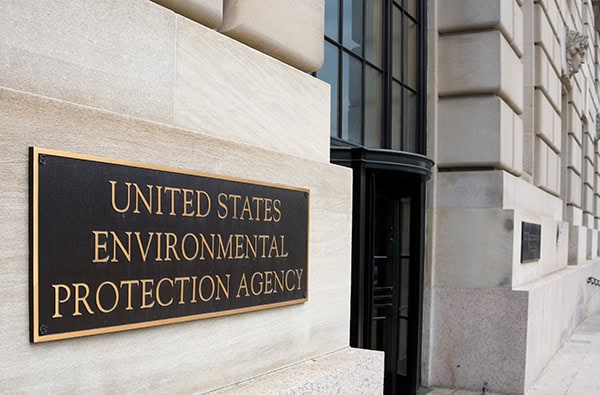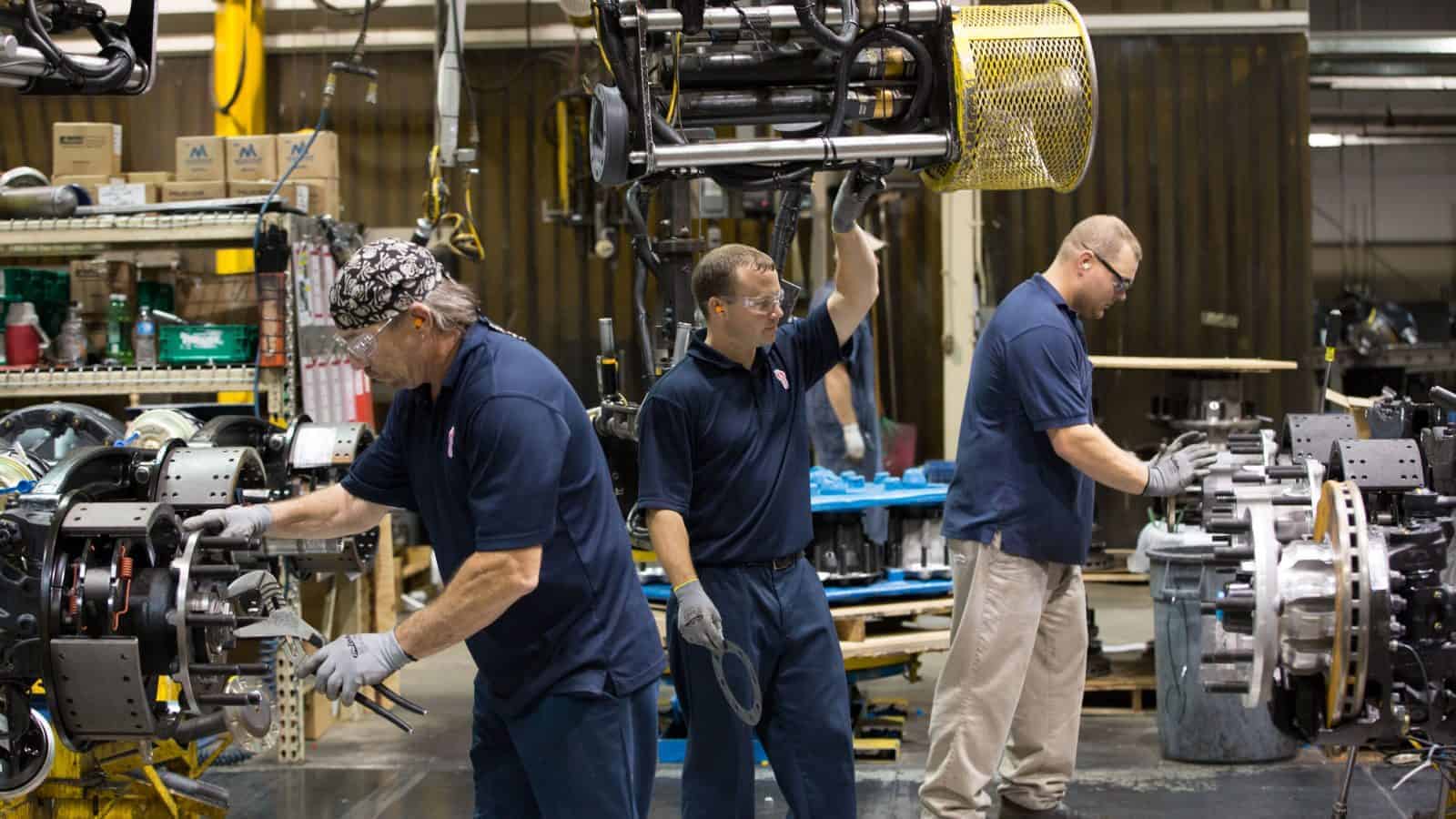NAM and Allies: PM2.5 Standard Will Hurt Manufacturers, Economy

The EPA’s overly stringent final rule on particulate matter puts continued U.S. innovation and economic growth in jeopardy, the NAM and allied groups told congressional leaders Monday.
What’s going on: In March, the EPA lowered the standard for particulate matter, or PM2.5, in its National Ambient Air Quality Standards rule by 25%, down from 12 micrograms per cubic meter of air to nine.
- This week, the NAM, along with 58 allied organizations, urged key House and Senate members to act soon to “stop this harmful rule before it takes effect.”
Why it’s important: The probable negative effects of allowing the change include “making it more difficult to create jobs, build cutting-edge factories and lead the world in the development of products that will shape modern life in the decades ahead,” the groups said.
- Compliance costs could exceed $1.8 billion, according to the agency’s own estimates.
- The lowered limit also puts the U.S. at a great disadvantage to global competitors, which “have adopted standards that are less stringent than the EPA rule and are phased in over a much longer time frame.”
What needs to happen: Congress should pass a resolution of disapproval regarding the new standard immediately.
Manufacturing Job Openings Decline

The number of U.S. job openings in manufacturing decreased in March, according to new data from the U.S. Bureau of Labor Statistics.
- Meanwhile, the number of job openings in the larger economy remained about the same, at approximately 8.5 million.
What’s going on: There were 570,000 open positions in the U.S. manufacturing industry in March, down from an adjusted 587,000 in February.
- Open positions in durable goods manufacturing also declined, to 353,000 in March from an adjusted 379,000 in February.
- Openings in nondurable goods, however, inched up to 217,000 from an adjusted 208,000.
Hires and quits: Hiring in the sector remained about the same as the last reading, coming in at 323,000 in March (down marginally from February’s 324,000).
- Total separations—which include quits, layoffs, discharges and other severance of employment—decreased slightly in March (to 330,000) from February (an adjusted 338,000).
House Committee Forms Working Groups to Revive Tax Provisions

Following a steady drumbeat of advocacy by the NAM, the House Committee on Ways and Means has formed tax working groups dedicated to finding legislative solutions to the scheduled expiration of pro-growth tax policies at the end of 2025.
What’s going on: Each of the 10 working groups will focus on an area of the economy that will be affected by the sunsetting of certain measures in the Tax Cuts and Jobs Act.
- Ways and Means Committee Vice Chairman Vern Buchanan (R-FL) was selected to lead the American Manufacturing tax working group.
- The members of Congress assigned to this team will examine the effects of pro-growth tax policies on the manufacturing sector.
Why it’s important: “Tax reform was rocket fuel for manufacturers: 2018, the first year the Tax Cuts and Jobs Act was in effect, was the best year for manufacturing job creation in the previous 21 years,” said NAM Managing Vice President of Policy Chris Netram. “But those gains are at risk as key tax provisions expire, making it more difficult for companies throughout the supply chain to hire, invest and grow. Congress must build on the promise of tax reform to ensure that manufacturing in America remains strong.”
- Earlier this month, Husco President and CEO and NAM Executive Committee member Austin Ramirez testified before the House Ways and Means Committee about the TCJA’s positive effect on manufacturing growth and the need for Congress to preserve the pro-growth business provisions of that legislation.
- Their expiration “mean[s] that pass-through businesses like Husco will have more of our income subject to a higher rate of tax,” Ramirez said. “At the same time, the pass-through deduction will expire completely, doubling down on the tax hikes that we face. … [A]llowing tax reform to sunset will undermine much of the progress we’ve made since 2017.”
What we’re doing: The NAM will be engaging with each of the tax working groups over the next several months to ensure that manufacturing-critical tax provisions are extended and reinstated.
- To get involved, reach out to NAM Senior Director of Tax Policy Alex Monié.
Inflation Stayed Elevated in March

Inflation, as measured by the Federal Reserve’s preferred gauge, remained elevated last month (CNN).
What’s going on: “The Personal Consumption Expenditures price index … accelerated to 2.7% for the year ended in March. … That rate was above economists’ expectations for a 2.6% gain and landed above February’s reading of 2.5%.”
- Prices increased 0.3% on a monthly basis, the same pace as in February.
Core PCE: So-called “core” PCE, which excludes often-volatile food and energy prices, remained steady at 2.8%.
Spending: Consumer spending stayed strong in March, rising 0.8% from February and exceeding economists’ expectations.
Noncompete Ban Would Disrupt Manufacturing in the U.S.

The Federal Trade Commission’s vote this week to prohibit noncompete agreements between employers and their employees threatens manufacturing in the U.S., the NAM said Tuesday.
What’s going on: In a 3–2 vote Tuesday, commissioners finalized a rule that, like a draft version circulated last year, “would deem practically any noncompete clauses for paid staff, independent contractors and unpaid workers to be an unfair method of competition rendered unenforceable, and [would require] employers to tell current and former employees they’ve stopped enforcing them” (Law360, subscription).
- The final rule is set to go into effect 120 days after it is published in the Federal Register, but lawsuits have been filed against it already, and additional legal action is expected.
What’s changed: One change made to the final rule following the receipt of more than 26,000 comments on it allows existing noncompete agreements with senior-level executives to remain in effect.
- Another difference between the rule’s prior iteration and the final is to the ban’s sole exception. The draft “permitted noncompetes for individuals selling their business or a substantial stake of at least 25%.” That threshold is not in the final version.
Why it’s problematic: The rule “is unprecedented and threatens manufacturers’ ability to attract and retain talent,” said NAM Managing Vice President of Policy Chris Netram.
- “In addition, [it] puts at risk the security of intellectual property and trade secrets—anathema to an industry that accounts for 53% of all private-sector R&D.”
- A noncompete ban would disrupt the majority of U.S. manufacturing operations, a 2023 NAM survey found.
What’s next: The NAM is considering all options in response to the final rule and is in active discussion with congressional leadership and the relevant committees of jurisdiction.
New Overtime Rule Will Cost Employers and Workers

A new final overtime rule from the U.S. Department of Labor will reduce flexibility for employees and could force manufacturers to make difficult choices about their workforces, the NAM said Tuesday.
What’s going on: The new regulation “changes the salary threshold used to determine whether a worker is exempt from overtime pay” so that, beginning Jan. 1, 2025, most employees earning less than $58,656 will be owed time-and-a-half wages for hours worked over 40 in a single workweek (Bloomberg Law, subscription).
- The current salary threshold is $35,568.
- The new rule will go into effect July 1, following publication in the Federal Register.
Why it’s problematic: The change promises to present significant challenges to employers and employees alike.
- “Quarter after quarter, manufacturers cite workforce issues, such as attracting and retaining skilled employees, as their biggest business challenge,” said NAM Managing Vice President of Policy Chris Netram. The “rule places new constraints on employers, reduces flexibility for the workers who will be reclassified and may force companies to make painful choices that limit both job creation and growth opportunities available to employees.”
What’s next: The NAM is weighing all actions to protect manufacturers across the country.
Manufacturers: Noncompete Decision Threatens Manufacturers’ Ability to Protect IP
Washington, D.C. – Following the Federal Trade Commission’s vote in favor of a rule that would prohibit employers and their employees from entering noncompete agreements, National Association of Manufacturers Managing Vice President of Policy Chris Netram released the following statement:
“The FTC’s rule banning noncompete agreements is unprecedented and threatens manufacturers’ ability to attract and retain talent. In addition, today’s action puts at risk the security of intellectual property and trade secrets—anathema to an industry that accounts for 53% of all private-sector R&D.
“An NAM survey found that 66% of respondents—manufacturers of all sizes—said the ban would interfere with their operations, and nearly half said it would impact employee training programs. The ban could force manufacturers to revamp their human capital operations completely, enact burdensome controls or silo parts of their operations from each other, which would result in less training for employees, less collaboration, less innovation and less efficiency. The NAM will weigh all options in response to the commission’s vote, so that well-paying manufacturing jobs and innovation are not compromised.”
-NAM-
The National Association of Manufacturers is the largest manufacturing association in the United States, representing small and large manufacturers in every industrial sector and in all 50 states. Manufacturing employs nearly 13 million men and women, contributes $2.89 trillion to the U.S. economy annually and accounts for 53% of private-sector research and development. The NAM is the powerful voice of the manufacturing community and the leading advocate for a policy agenda that helps manufacturers compete in the global economy and create jobs across the United States. For more information about the NAM or to follow us on Twitter and Facebook, please visit www.nam.org.
Manufacturers: DOL Overtime Rule Will Exacerbate Workforce Crisis
Washington, D.C. – Following the release of the Department of Labor’s Wage and Hour Division rule concerning updates to the overtime regulations, National Association of Manufacturers Managing Vice President of Policy Chris Netram released the following statement:
“Quarter after quarter, manufacturers cite workforce issues, such as attracting and retaining skilled employees, as their biggest business challenge. Yet today’s rule places new constraints on employers, reduces flexibility for the workers who will be reclassified and may force companies to make painful choices that limit both job creation and growth opportunities available to employees. In addition, this latest regulatory hurdle will complicate manufacturers’ efforts to fill the millions of jobs our industry is projected to create within a decade.”
-NAM-
The National Association of Manufacturers is the largest manufacturing association in the United States, representing small and large manufacturers in every industrial sector and in all 50 states. Manufacturing employs nearly 13 million men and women, contributes $2.89 trillion to the U.S. economy annually and accounts for 53% of private-sector research and development. The NAM is the powerful voice of the manufacturing community and the leading advocate for a policy agenda that helps manufacturers compete in the global economy and create jobs across the United States. For more information about the NAM or to follow us on Twitter and Facebook, please visit www.nam.org.
Manufacturing Output Slows

Manufacturing output slowed in April, according to index provider S&P Global.
What’s going on: While overall business activity continued to grow this month—albeit at a slower pace—manufacturing growth eased.
- S&P Global’s Flash US Manufacturing PMI came in at 49.9, a four-month low and down from March’s 51.9.
- Any number below 50 indicates contraction.
Why it’s happening: The decline in orders can be linked “to inflationary pressures, weak demand and sufficient stock holdings at customers.”
However … Employment in manufacturing in April rose modestly.
What it means: “[T]he drivers of inflation have changed,” said S&P Global Market Intelligence Chief Business Economist Chris Williamson. “Manufacturing has now registered the steeper rate of price increases in three of the past four months, with
factory cost pressures intensifying in April amid higher raw material and fuel prices.”
Manufacturers: Unprecedented Use of CERCLA Authority Will Hamper President’s Manufacturing Vision
Washington, D.C. – Following the release of the Environmental Protection Agency’s rule designating perfluorooctane sulfonic acid, also known as PFOS, and perfluorooctanoic acid, also known as PFOA, as hazardous substances under the Comprehensive Environmental Response, Compensation and Liability Act, National Association of Manufacturers Managing Vice President of Policy Chris Netram released the following statement:
“Manufacturers support efforts to mitigate harmful chemicals from impacting our environment and the health of our nation, but this unprecedented use of CERCLA authority by the EPA will only hamper President Biden’s vision of growing the manufacturing sector in the U.S. The unique and unmatched chemical bond of these compounds means that there are no existing replacements for the critical products they make up.
“The NAM is not opposed to commonsense regulations of PFAS chemicals, and manufacturers are committed to environmental stewardship, while recognizing in many cases we will need to continue to use these chemicals for the foreseeable future. However, designating these compounds as hazardous substances is a blunt, overreaching decision that will make it harder for our industry to create innovative products and jobs.”
-NAM-
The National Association of Manufacturers is the largest manufacturing association in the United States, representing small and large manufacturers in every industrial sector and in all 50 states. Manufacturing employs nearly 13 million men and women, contributes $2.89 trillion to the U.S. economy annually and accounts for 53% of private-sector research and development. The NAM is the powerful voice of the manufacturing community and the leading advocate for a policy agenda that helps manufacturers compete in the global economy and create jobs across the United States. For more information about the NAM or to follow us on Twitter and Facebook, please visit www.nam.org.
